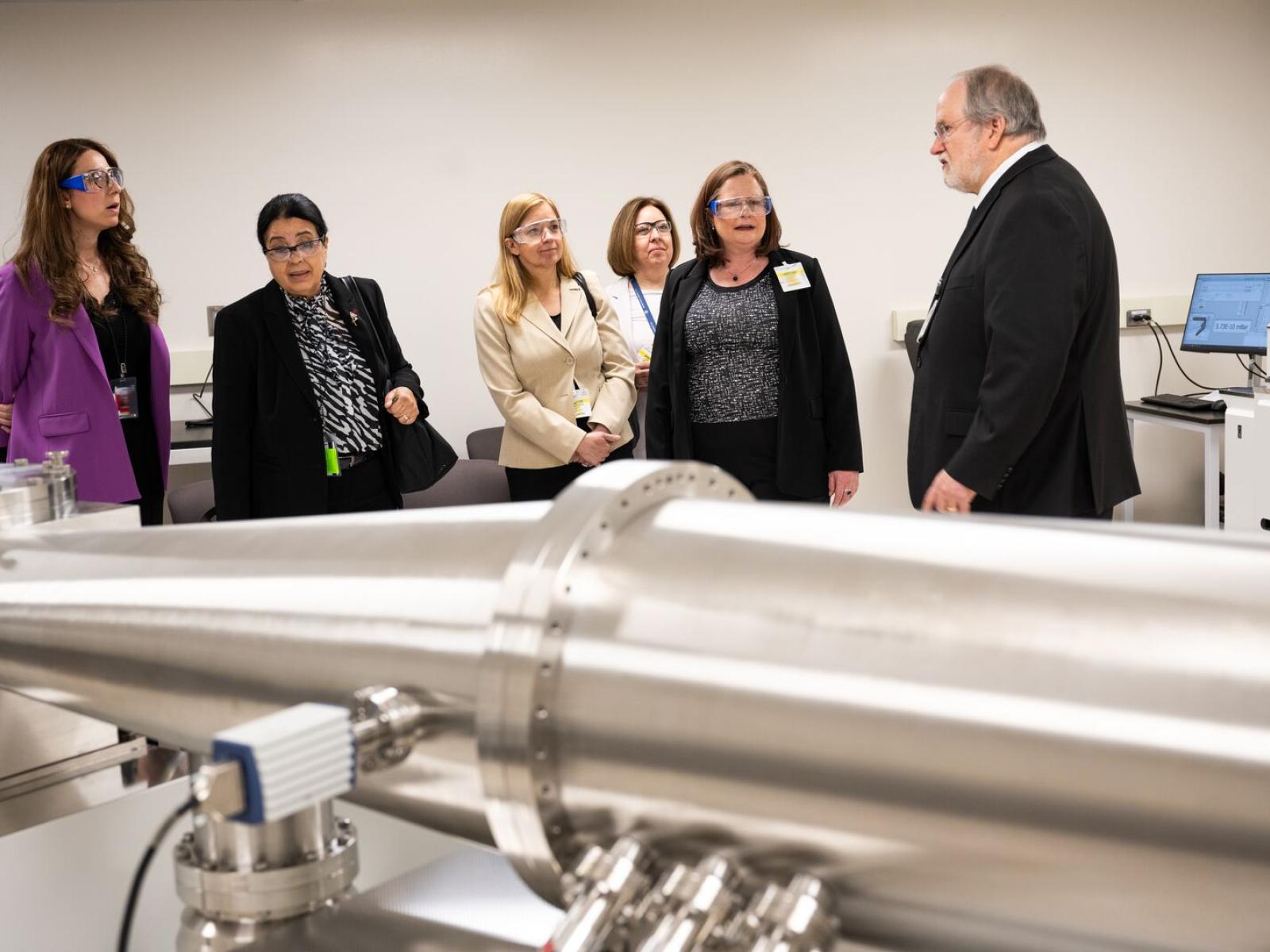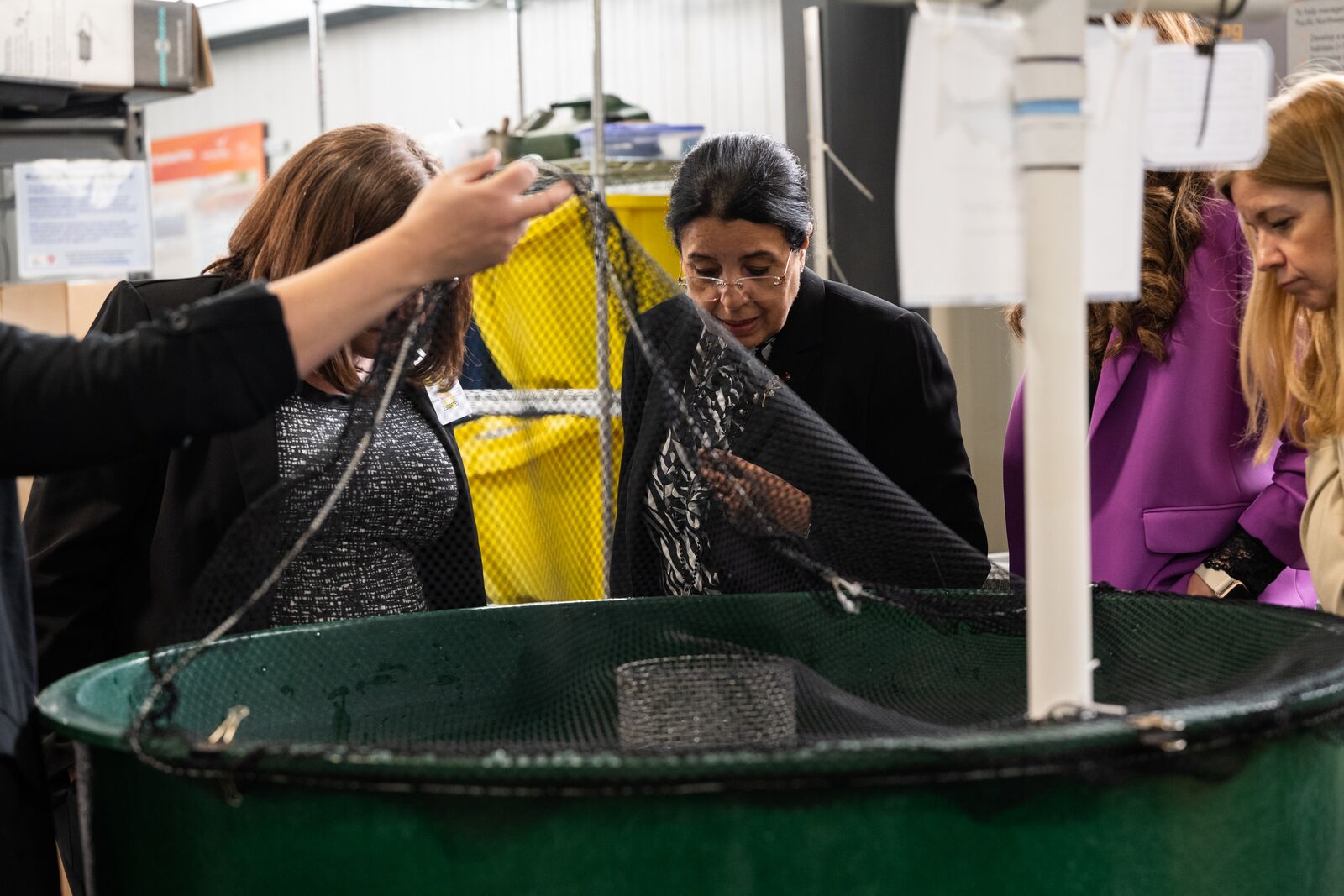IAEA Deputy Director General Visits Richland and Sequim Campuses

Getting a peek at the new mass spectrometer for PNNL’s International Atomic Energy Agency (IAEA) work. From left, IAEA Programme Officer Noura El-Haj; IAEA Deputy Director General Mokhtar, U.S. Department of State (DOS) Political Officer Lisa Wilkinson, DOS Senior Foreign Affairs Officer Christine Riendeau Martin, and Ambassador Holgate listened as PNNL Earth scientist Eirik Krogstad described the new, one-of-a kind mass spectrometer that DOS purchased for PNNL’s use as a member of the IAEA Network of Analytical Laboratories.
(Photo by Andrea Starr | Pacific Northwest National Laboratory)
Pacific Northwest National Laboratory (PNNL) was honored to host International Atomic Energy Agency (IAEA) Deputy Director General and Head of the Department of Nuclear Sciences and Applications Najat Mokhtar, who was accompanied by U.S. Ambassador to the Vienna Office of the United Nations and to the IAEA Laura Holgate on a visit to Richland on April 25 and to the Sequim campus on April 26. Other visitors in the group included IAEA Programme Officer Noura El-Haj, U.S. Department of State (DOS) Political Officer Lisa Wilkinson, and DOS Senior Foreign Affairs Officer Christine Riendeau Martin.
The visit was initiated by the DOS to facilitate introductory meetings between PNNL experts and Deputy Director General Najat Mokhtar’s team to discuss areas of mutual research interests, such as marine monitoring and plastics pollution, and to explore potential future collaboration. The visitors were also interested in organizing discussions on strategic laboratory management issues.
In her introduction of Mokhtar, Ambassador Holgate recalled the inspiration for the IAEA in the 1953 “Atoms for Peace” speech by President Dwight D. Eisenhower to the United Nations General Assembly. The IAEA was founded in 1957 to promote the applications of nuclear science and technology for peace and development around the world. While many staff at PNNL are familiar with the nuclear safeguards efforts of the IAEA, equally important is the mission to use peaceful nuclear technology to improve the well-being and prosperity of developing countries. “In visiting PNNL with Deputy Director Mokhtar, I would like to raise the awareness of IAEA’s work to help Member States advance the United Nation’s Sustainable Development Goals,” said Ambassador Holgate.
Deputy Director General Mokhtar’s opening remarks described the broad objectives of the IAEA’s programs to use nuclear technology to provide safe food, clean water, better health, efficient industry, clean environment, and a sustainable future for the people of Member States. She described the work of the 12 IAEA laboratories under her management as applied research, capacity building, and technical services to help Member States obtain accurate data.
The visitors toured the 331 Building on the Richland campus to see the freshwater aquatics laboratory and to view a new mass spectrometer that PNNL will use as part of the IAEA Network of Analytical Laboratories. While in Sequim they learned about marine carbon dioxide removal, marine algae research, autonomous surface vehicles, plastics pollution monitoring, and environmental monitoring. Deputy Director General Mokhtar and Ambassador Holgate also met with PNNL leaders to learn more about the national laboratory system and PNNL’s approach to facility stewardship, research strategy, operational excellence, and transition to a net-zero carbon campus.

PNNL Director Steve Ashby expressed his appreciation for the engagement of the IAEA and the opportunity to share PNNL’s nuclear science and technology and nonproliferation expertise. “We look forward to exploring further how PNNL can bring our myriad capabilities to bear on IAEA’s important mission of global nuclear security.”
Facilities
Published: May 13, 2024